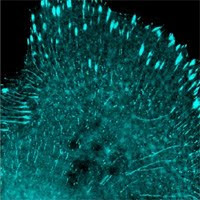Judging
from the hundreds of papers published using camelid VHH antibodies as
reagents, there are probably thousands of researchers who have
experience with this type of antibodies by now. We like to call the
~15kD camelid VHH antibody nano antibody or nAb
TM. Once someone experiences how well a nAb works for co-IP using a
fluorescent protein as tag, they often wonder what it takes to bring nAbs to broader use.
The success of a nAb project starts with the antigen presentation.
It is critical to build the capability to produce large quantities of
recombinant antigen for immunization. At Allele, our scientists also
established some unique presentation formats for traditionally difficult
targets (e.g. large membrane proteins).
After llama immunization, the next step is screening.
With the goal of creating large scale nano antibodies against diverse
targets, we have developed multiple high throughput screening methods to
cover very large, diverse libraries generated from immunized animals.
The technologies will continue to evolve as the scale of nAb generation
continues to expand. We have the ability to functionally screen for
site-blocking antibodies and antibodies that only recognized natively
folded targets, or targets in their naturally occurring presentations.
A
nAb isolation project does not end with the obtaining of a cDNA clone.
Or, if it does, the nAb is probably not as great as what Allele Biotech
has been offering. In our hands, all nAbs go through an engineering step
beginning with the generation of a 3D structural model of the isolated
clone. We use structure-guided design to alter the protein, allowing us
to improve its properties. This includes increasing affinity,
solubility, or altering the protein to improve performance for specific
applications. We also like to use known structures of traditional
monoclonal antibodies to assist camelid VHH antibody engineering against
specific targets.
With a finalized clone in hand, the next step is to establish protocols for commercial production.
The Allele team spends a tremendous amount of effort aimed solely at
high-yield, low-cost recombinant VHH antibody production in a variety of
formats, so that the costs for other scientists to take advantage of
these great reagents can be kept as low as possible.
Last but not the least, nAb labeling,
including conjugating stable soluble VHH antibody to solid supports for
immunoprecipitation or to fluorophores for detection, requires
additional expertise and tight operation control. However, our vision
is to have a modular system for antibody labeling that will enable the
end user to select from a variety of fluorophores and other detection
tags, which can be instantaneously and irreversibly coupled via simple
mixing.
Note added: we work with commercial (diagnostic and clinical) partners from
developing nAbs
all the way to the market. We have expert scientists available to
customers and licensees for consultation and troubleshooting antibody-
and imaging-related questions and problems.



